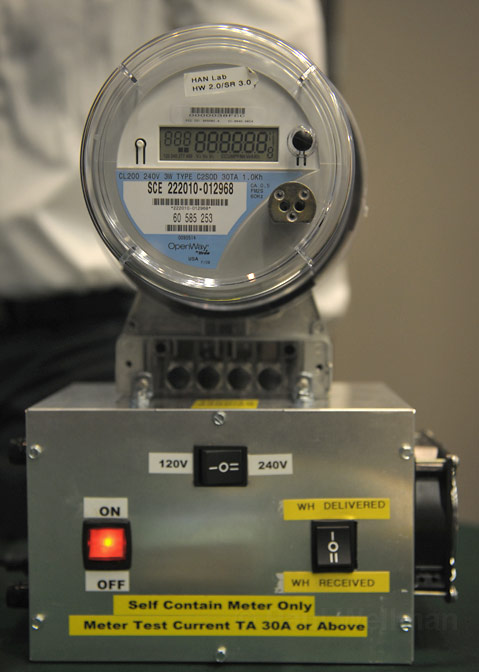Smart Meters Can Be Postponed If Homeowners Act Today
Joining the ‘Delay List’ Temporarily Halts the Switch to a Digital Meter
Smart meters—automatic, two-way, wireless electrical-energy monitoring and control devices—and the possible effects of their grids have sparked a Goleta City Council protest. Despite being warned by city staff that Southern California Edison would have its way no matter what, the council has unanimously agreed to protest SCE’s installation plan to the California Public Utilities Commission (CPUC).
Citing concern over “health and privacy issues,” the February 22 letter to CPUC President Michael R. Peevey requested the commission provide customers a “no-cost opt-out” from Edison’s plan to switch from the present human-read analog meters to radio-frequency, remote-controlled digital meters.

While smart meters are scheduled to arrive in March in the City of Goleta, among other jurisdictions, there may still be time to request a delay from Edison and its partner, Corix Utilities, which is actually switching out the old meters. Customers can call (800) 810-2369 (or for Spanish speakers [800] 477-4455) to get on the Delay List; an employee will come to your home and tag the old meter.
Supposedly, customers will be alerted by letter 30 days in advance of the switchover, but don’t bank on it; act now to get on the Delay List. I received my letter about a week before this column was published. The Corix number ([877] 407-2317) on the letter also allows access to the Delay List.
Goleta’s protest joined scores of similar ones from municipalities throughout the state, including the city and county of Santa Barbara. The pushback against the utilities’ plans, which were originally proposed in 2007-08, resulted in the CPUC mandating an opt-out choice for Pacific Gas & Electric’s territory in Northern and Central California. It took effect February 1.

Unfortunately, the CPUC, which has paramount authority, also decided it would allow PG&E to charge its customers an initial fee of $75 and an indefinite monthly fee of $10 to continue to use their analog meters. The howls of outrage ignited by this decision were punctuated by threats of class-action lawsuits.
As of this writing, the CPUC has not announced a decision on an opt-out scheme for the southern parts of the state served by SCE and San Diego Gas and Electric. Additionally, Edison’s FAQ Web site states that once the meters are installed “SCE cannot accommodate uninstall requests at this time.”
As a journalist, these are reasons to delay installing a new system that could affect my family’s health and the function of other home electrical devices. Researching the complexities of what smart meters are and do has stirred concerns I want answered.
Despite the reassurances of Edison’s representatives and its Web site, as customers learn more, the controversies increase over the technology’s health impacts, potential invasion of homeowner privacy, and even if the alleged energy savings and efficiencies are real.
Though SCE maintains its Itron meters are “highly accurate” and have been tested “in the field to ensure that our smart meters are safe, accurate and working properly,” no wide scale, real-world test of the meter has been done, according to a November 2011 Sage Associates report. (The Montecito-based environmental consulting firm specializes in analyzing radio frequency projects, such as antennas and smart meters.)
SCE is apparently relying on a 2010 report by a consultant for the industry-financed Electric Power Research Institute (EPRI), which mainly consisted of measurements from two artificial smart-meter test farms in Southern California and South Carolina and a five-minute street test. The EPRI report is filled with qualifiers and limitations regarding the consultant’s conclusions on smart-meter safety.
This hardly seems a basis on which to charge into a long-term experiment on human health and radio waves. Consider the cumulative effects of exposure and it gets worse.
“What is lacking in this and other … reports on smart meters is recognition that many tens or hundreds of thousands of meters are installed at very close proximity to occupied space in homes,” notes the Sage critique. These smart meters “talk” to each other 24/7 as well as send pulses of data to collector cells for relay to the whole network; I’ve seen no measurements on how high the radio-frequency levels are around these special cells.
Perhaps this is a reason why Edison’s Web site does not answer a fundamental question: Do we know enough about the accumulated long-term effects of low-emission radio frequencies on the human body and brain to unleash this technology now on not only Goletans but all Californians?
While thinking about that, note that Southern California Gas Company is planning over the next five years to roll out what they call a “gas advanced meter communication device.” It is claimed to be able to “securely transmit … gas usage data” in a fraction of a second and does not interact with other gas meters or home appliances.
(Disclosure: My wife, Dr. Ingeborg Cox, has testified before the Goleta City Council about possible public health issues associated with these types of exposures.)



